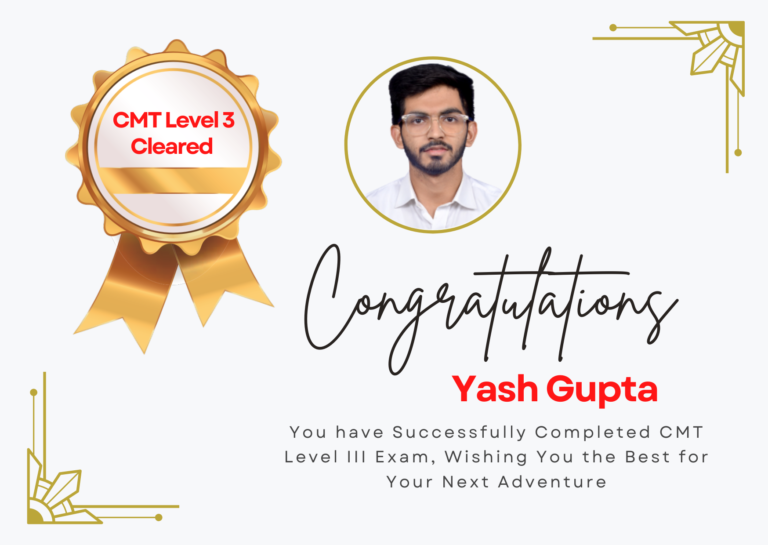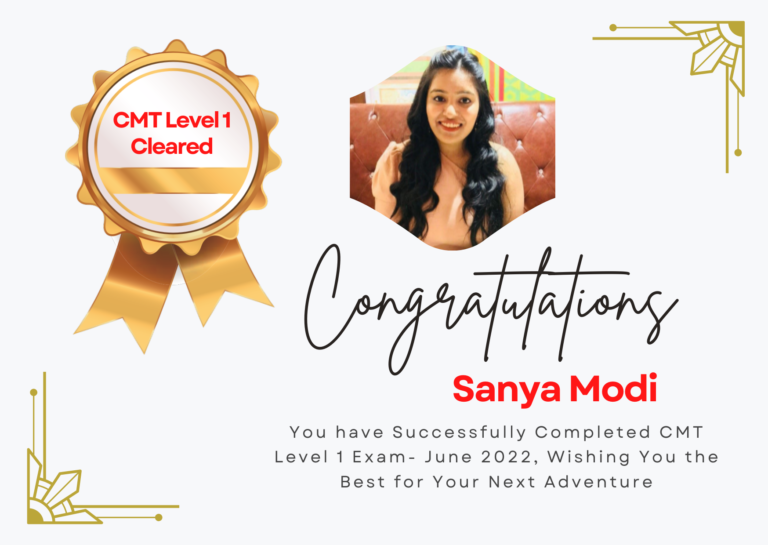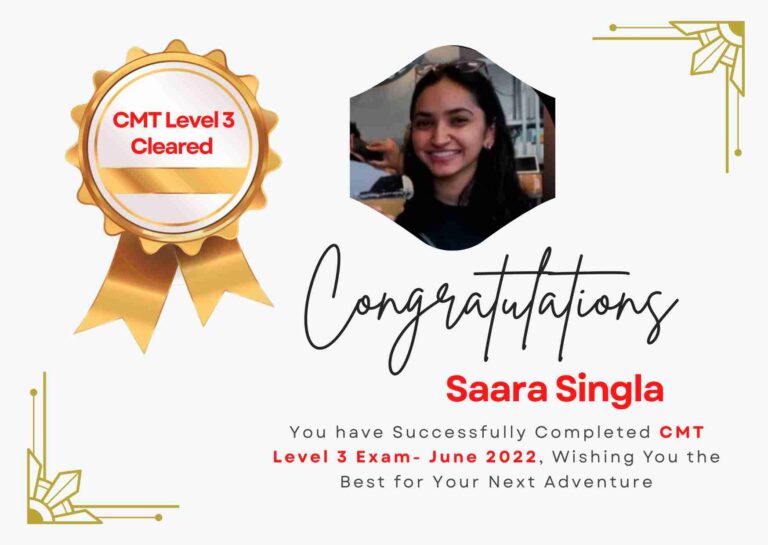- +91 9261 2110 03
- ptaimp@gmail.com
- Mon - Sat: 8:00 - 20:00
Grab International Financial Professional in the Field of Research & Trading Strategies.
Challenging Career with high growth opportunities

Constructing Charts: 5%
Scaling methods (arithmetic, logrithmic, semi-log)
Line charts
Bar charts
Candlestick charts
Point and figure charts
Volume
Trend Analysis: 16%
Trendlines
Regression analysis
Moving averages
Chart and Pattern Analysis: 23%
Classic pattern recognition
Candlestick pattern recognition
Elliot Wave principal
Fibonacci price analysis
Support and resistance
Relative strength index (RSI)
Moving average convergence/divergence (MACD)
Bollinger bands
Stochastics
Confirmation: 3%
Open interest and volume
Theory and History: 9%
History of financial markets (historical market events, bubbles, crashes)
History of technical analysis
Modern Portfolio Theory
Dow theory
Behavioral finance
Markets 5%
Historical market data (non-trading days/hours, characteristics of various markets)
Traditional asset classes (equities, fixed income, commodities)
Alterative asset classes (derivatives, private equity, managed futures, real estate)
Currencies
Non-US markets
Market indices
Exchanges
Markets Indicators: 7%
Breadth indicators (A/D, up/down, volume)
Index construction
Government/Fed reports (treasury data, monetary policy, Fed holdings, CPI)
Private money flows (mutual fund holdings, corporate liquidity holdings)
Sentiment measures (put-call ratio, investor polls)
Volatility (VIX, historical, implied)
Cycles: 5%
Business cycles
Selection and Decision: 13%
Relative strength
Forecasting techniques (pattern and trend recognition)
System Testing: 5%
Backtesting
Order execution and slippage
Statistical Analysis: 6%
Descriptive statistics (mean, median, mode)
ETHICS AND STANDARDS OF PRACTICE – 3%
Constructing Charts: 3%
Volume
Trend Analysis: 15%
Trendlines
Multiple time frame analysis
Breakouts (from channels or chart patterns)
Moving averages
Trend strength indicators (DMI, ADX, etc.)
Chart and Pattern Analysis: 15%
Gap analysis
Support and resistance
Confirmation: 6%
Oscillators and divergence
Sector rotation
Intermarket signals
Theory and History: 5%
Behavioral finance
Adaptive Market Hypothesis
Market Indicators: 8%
Breadth indicators (A/D, up/down volume)
Index construction
Sentiment measures (put-call radio, investor polls)
Volatility (VIX, historical, implied)
Cycles: 3%
Seasonal cycle
Selection and Decision: 10%
Non-correlated assets
Relative strength
Forecasting technique (pattern and trend recognition)
Risk Management: 15%
Absolute and relative risk (total risk v. risk compared to benchmark)
Risk modeling
Value at risk
Volatility risk
Liquidity risk
Diversification
Stops v. hedging
Leverage risk
Portfolio risk management (market neutral, hedging strategies)
Measures of risk (maximum cumulative drawdown, net profit to drawdown, maximum consecutive losses, largest losses, longest flat time, time to recovery, maximum favorable and adverse excursions)
Risk-based performance measures
System Testing – 10%
Algorithmic development
Optimizing entry and exit rules
Equity curve analysis
Position size rules (Tharp’s methods, Kelly criterion, Optimal f)
Profit measures (profit factor, outlier-adjusted profit to loss, percentage of winning trades, annualized rate of return, payoff ratio, length of average winning trade, efficiency factor)
Statistical Analysis: 7%
Inferential statistics (correlation, regression, t-test)
ETHICS AND STANDARDS OF PRACTICE – 3%
Risk Management – 21%
Risk management (basics of probability & statistics, modeling risk factors, number of assets and impact on portfolio, managing risk through correlation, VAR, performance and risk metrics, market volatility and fat-tailed distributions, correlation and diversification, managing individual trade risk, managing risk for an entire portfolio)
Position sizing
Quantitative and Statistical analysis
System development and testing
Asset Relationships – 18%
Intermarket analysis
Relative strength
Sector rotation
Portfolio Management – 18%
Portfolio management (performance measurement, portfolio allocation, asset correlation, asset allocation, alternative investments, risk management with alternatives)
Classical Methods – 21%
Sentiment
Market breadth
Market forecasting
Price patterns
Volume study and analysis
Candlestick analysis
Oscillators or various technical studies
Behavioral Finance – 10%
Behavioral finance
Volatility Analysis: 7%
Volatility Analysis
ETHICS AND STANDARDS OF PRACTICE – 5%
Every Brokerage house required analyst to help their customers in personal to take wise & viable decision making to trade in various instrument in the financial markets.Brokerage Houses business is mainly depend on analyst performance which create best return for the customers.
All financial decision making requires best trading strategy that works in all kind of markets. For maximize profits every investor require trading strategy with minimize risk involved in portfolio. Derivative analyst help customers to create most suitable trading strategy according to the condition prevail in markets.
Now a days brokers provide complete financial planning solution which includes investment, insurance, retirement planning & tax planning.They provide personalized services & solutions to their customers to fulfill their financial needs on every day basis.
Candidate is ready to become registered research analyst licensed by SEBI to provide the research & trading strategies to their customers . Candidate also represent their advises on the public domain like website or financial news channel.
Relationship manager play a vital role in the revenue generation for the organization. He is manage front end operation & directly managing customers on personal basis. A active & efficient relationship manager create brand & reputation & help organization to achieve their goals.
After attaining the necessary skill , knowledge of markets & tools & application of trading strategies in real time markets along with back testings. Candidate also offering services of personalized portfolio management services or working with the portfolio management services based companies.
Happy Faces Of Our CMT Holders, Successfully Completed CMT Level Exams






We are keep close working with industry needs & customized our program

To create corporate ready students we manage to provide internship with stipend and also provide certain industry certifications by professional bodies .

We constantly connect with the industry people and many recruiters to provide best advantage to the CMT students.

Industry Expert Faculty
Faculty in CMT Course require Industry Experts which also provide industry insights and current trend and changes in the Investment analysis & Technical Research Field.
Basically, CMT Full Form is Chartered Market technician is a designation for technical analysts worldwide. The CMT Certification Course demonstrates mastery of a core body of knowledge for technical analysis, portfolio management, and risk management. Our market philosophy is grounded in behavioral economics and extends beyond classical pattern recognition techniques to include quantitative approaches to market research and rule-based trading system design and testing.
A CMT Association Certified Chartered Market Technician needs to cover three levels to be cleared after you earn the designation of CMT.
Level I: Focusing on the basic knowledge of the terminology and analytical tools used in technical analysis.
Level II: Measuring the candidate’s competency in the application of concepts, theories, and techniques covered by the required readings.
Level III: Tests the candidate’s ability to integrate his or her understanding of the concepts identified in Level I with the practical application learned in Level
A Chartered Market Technician has mastery in the fields of technical analysis, managing investment risk, and portfolio management. CMT holders work on developing trading systems and play the gap between the intrinsic price and the market price of a particular asset class.
To get enroll in the cmt program firstly student have to create their account by visiting CMT association official site: https://cmtassociation.org Students need to register for the CMT Level 1 Exam with the association. Study with the updated CMT Level respected curriculum and also have to schedule a date and time for the prometric exam in a nearby prometric testing center.
The CMT- Chartered Market Technician Level exams are given twice a year, in June and December.
Chartered Market Technician Jobs are available with various designations like Investment Analyst, Portfolio Manager, Trading Strategist with Companies Related to Investment, Research, and Stock Broking.
There is no limit on the number of attempts candidates may make to pass each level of the CMT exams.
You may reschedule your exam within the current administration within five days before the exam date at no cost.
CMT Exam Level I – 2 hours
CMT Exam Level II – 4 hours
CMT Exam Level III – 4 hours
Level I – 132 multiple choice questions (Only 120 are counted, 12 are for piloting new questions)
Level II – 170 multiple choice questions (Only 150 are counted, 20 are for piloting new questions)
Level III – Essay questions totaling 240 points. Candidates should use the point allocation of each question as guidance for time management.
Level I – primarily definition & recognition – This exam measures basic, entry-level competence and understanding of technical analysis. The Level I candidate needs to have a working knowledge of the basic tools of a technical analyst.
Level II – primarily application & analysis – This exam requires the candidate to demonstrate a greater depth of analysis and use of technical tools. The Level II candidate is expected to demonstrate proficiency in applying more advanced analytical techniques and technical analysis theory.
Level III – primarily integration & synthesis – This exam tests the candidate on the development of logical and consistent research opinions, portfolio strategies and trading decisions based on a wide range of charts and technical data. The Level III candidate is asked to analyse case studies, make recommendations and justify those recommendations based on the data provided. All candidates must pass the ethics portion of this exam.
The CMT Board of Governors recommends the following minimum study hours for each Level of the CMT exam. These estimates are based on a college education and a background working in the financial markets:
CMT Exam Level I : 80 to 120 hours
CMT Exam Level II : 100 to 140 hours
CMT Exam Level III : 120 to 160 hours
Recommended study time differs from person to person based on experience with the subject, time working in the field, and prior knowledge of technical analysis. However, these are rigorous exams testing a broad body of knowledge. All candidates, regardless of work experience, must allocate appropriate time to prepare the material.
In India, CMT course fees depend on CMT course levels of registration, such as early bird, standard, and late registration, which also vary depending on the location itself. The CMT Levels Exam Fees are $625 without curriculum, and with curriculum, they vary around $900.
FINRA has amended FINRA Rule 1050 to provide an exemption from the analysis portion of the Research Analyst Qualification Examination (Series 86) for more details visit : https://cmtassociation.org/chartered-market-technician/series-86/
Main Knowledge of Domain:
Quantitative Research & Trading
Risk Management
Applied Behavioral Finance
Portfolio Management
Nowadays, the Chartered Financial Analyst board also controls CMT designation. CFA is a program based on financial asset valuation & portfolio management on the basis of Fundamental analysis & investment valuation whereas CMT designation solely used portfolio management technique based on quantitative methods like technical analysis.
Chartered Market technician is a designation controlled or maintained by the Master of technician association governed by the Chartered Financial Analyst Board USA whereas CFTe designation is managed by the International Federation of Technical Analyst .
Generally, CMT programs use the percentile basis for determining passing rates. If a candidate scores an average of 70–75%, then there are great chances to clear exams.
The CMT requires the following minimum qualifications or eligibility requirements: candidates must have a university degree and work experience in the financial markets using technical analysis.
Ask Queries to Your Mentor
As a matter of fact you can watch live market trading that helps you to connect with CMT. Join a Technical Analysis Course which works on real time markets by using tools & techniques . That’ll give you behavioural understanding of real time Share market. Understanding the money management by real time trading or investment activity. As we know CMT is an MCQ Exam & ask question on application level. Create short notes of Course Content. Get PPT based Short Notes & note interpretation of tools & Techniques on technical analysis. Short Notes help you out to quick revision at the CMT exam time. CMT Books have very complicated language & course content is not properly aligned as it takes topics from various books of different writers.
So we have to take individual topics and understand concepts in simple, Concise and Clear manner. Take content from various books or websites like Investopedia or Stock Charts on Each Topic for in-depth understanding. Apply tools & techniques with the help of Technical analysis or trading software’s. Read Books twice as MCQ can be created from a single line. while study mark important topics.